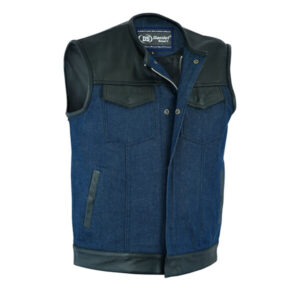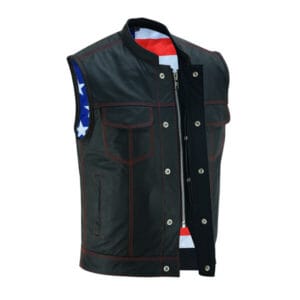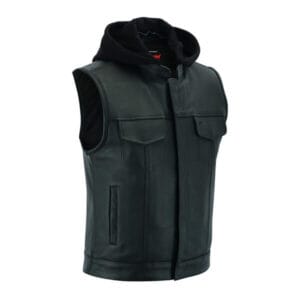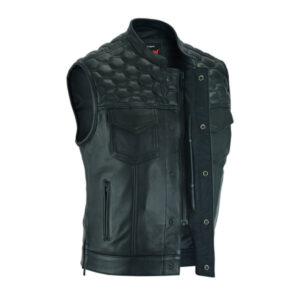Biker culture’s unique and rebellious attitude has long fascinated people. Bikers are more than leather jackets, loud engines, and scary attitudes, despite media portrayals. Few subcultures offer freedom, camaraderie, and loyalty like this. Biker culture is very personal, whether through rituals or friendships. Understanding this culture’s complexities is necessary to appreciate its uniqueness in a mainstream environment.
Biker Culture and Its Symbols
Freedom, commitment, and camaraderie define biker culture, a complex subculture. Many of its members’ symbols, patches, and numbers define it. These insignia represent their club’s ideals, history, and traditions, not merely decoration. Understanding the underlying significance of these symbols helps us appreciate the biker lifestyle and its strong relationships.
Mens Black Leather SOA Anarchy Outlaw Biker Vest
1.1 Motorcycle Club Symbols Matter
Motorcycle club symbols, especially patches or “colors” worn on jackets and biker vests, are key in representing club identity, membership, and hierarchy. Originating after WWII, these symbols often feature the club’s name, logo, location, and elements like skulls or wings.
Numbers and letters hold special meaning, such as “13” symbolizing rebellion or marijuana, and “81” representing the Hells Angels. Other symbols include the “1%” patch for outlaw status and acronyms like “FTW” reflecting commitment to the biker lifestyle.
Together with tattoos and hand gestures, these symbols form a language within the biker community, reinforcing values like freedom, strength, and defiance of societal norms.
Historical Context for 13
The number 13 has long been a mysterious symbol of superstition and resistance across cultures. In subcultures like bikers, it symbolizes disobedience against norms. Its reputation as an “unlucky” or forbidden number dates back centuries. Understanding the number 13’s history helps explain why it is so special and feared in many civilizations.
2.1 Subculture Numbers Matter
Many subcultures use numbers to express group identity, allegiance, and rebellion. In motorcycle culture, the number 13 is often seen on patches and tattoos, representing the 13th letter of the alphabet, “M” for marijuana, signaling use or trade. Beyond bikers, 13 frequently symbolizes rebellion and being outside mainstream society.
Subcultures often adopt stigmatized numbers, like 13, to embrace their outsider status. Associated with bad luck, 13 appeals to groups valuing individualism, freedom, and defiance of authority, symbolizing strength and nonconformity.
Numbers can also reflect a subculture’s history and values. In biker culture, 13, like the 1% patch, represents rebellion and community principles.
Women’s Raw Finish Denim Vest W/Leather Trim
2.2 The Origins of 13 in Different Cultures
Superstitions around the number 13 are widespread, especially in Western cultures, where it is considered unlucky. This belief stems from Norse mythology, where Loki caused chaos as the uninvited 13th guest, and Christianity, where Judas, the betrayer, was the 13th apostle at the Last Supper.
While some cultures, like the Egyptians and Maya, viewed 13 as a symbol of renewal or time cycles, European history further linked it to bad luck, notably when the Knights Templar were arrested on Friday, October 13, 1307, reinforcing the association of 13 with misfortune.
2.3 Why Is 13 Unlucky?
Western tradition considers 13 unlucky, influencing architecture and daily life, with buildings often skipping the 13th floor and motels avoiding Room 13. This superstition partly stems from the idea that 12 is “complete” in numerology, representing balance (12 months, 12 zodiac signs), while 13 feels disruptive. Religion also plays a role, as Judas, the betrayer, was the 13th guest at the Last Supper, linking 13 to treachery and death. Triskaidekaphobia, the fear of 13, has shaped modern design and culture. Despite its bad reputation, some cultures see 13 as a symbol of luck or defiance for those challenging the norm.
What Does 13 Mean on a Biker Vest?
Biker insignia express a biker’s associations, views, and ideals. A biker’s vest’s 13 emblem is famous and mysterious. The meaning of this number is unclear to non-bikers, but it is significant among enthusiasts. Understanding the meaning of 13 helps us understand motorcycle culture’s inner identity, revolt, and loyalty. This number is more than a badge—it represents the wearer’s place in a distinct and misunderstood universe.
3.1 Biker Culture’s Number 13
Biker patches and vests commonly include the number 13 plainly or in more elaborate designs. Biker numerals are powerful symbols that symbolize the club’s values or the rider’s code.
Many motorcyclists associate 13 with outlawry, symbolizing their nonconformist lifestyle. It honors the 1% of bikers that defy society. Wearing 13 shows defiance, courage, and a determination to live as an outsider.
However, 13 typically has a marijuana-related significance. In biker slang, “M” is the 13th letter of the alphabet, and 13 often refers to marijuana use or legalization. This view fits many biker gangs’ countercultural and rebellious spirit.
Men’s Single Back Panel Vintage Brown Leather Motorcycle Vest
3.2 Interpretations of 13
The number 13 is usually connected with marijuana and the outlaw lifestyle; however, it can symbolize different things to different people or motorcycle clubs. Common number interpretations include:
Weed Reference
As said, 13 is sometimes short for marijuana, or “M”. Many motorcyclists wear 13 to show they use or support the drug. Motorcycle clubs are historically associated with counterculture organizations that oppose mainstream principles; therefore, this view fits the broader rejection of legal and societal norms.
Outlaw Mindset
Outlaw bikers wear 13 as a badge of pride, defying society. This interpretation is based on the 1%—the small fraction of bikers who break the law. Bikers in the “1% world”—those who live by their own laws and love the criminal lifestyle—may wear 13.
Brotherhood, loyalty
The number 13 represents fraternity and club devotion to certain bikers. It can indicate an almost spiritual attachment to the club and its principles. This interpretation emphasizes the number’s importance as a club symbol rather than its rebelliousness.
Numerical Superstition
Finally, Western societies have historically connected 13 with bad luck or danger. Bikers may boldly wear the number 13 to show they are willing to face any challenge or risk.
Men’s Leather/Denim Combo Biker Vest Blue
3.3 Outlaw Motorcycle Club Rule 13
In Outlaw Motorcycle Clubs (OMC), 13 is much more significant. These clubs have rigorous hierarchies, norms of conduct, and values-based emblems. These clubs are known for their lawlessness and independence from society, which is symbolized by 13.
A “1%er” is a biker that prides themselves on their outlaw status and wears the number 13 in several OMCs. It shows membership in a subculture that rejects laws and morals. This illegal lifestyle is publicly supported by wearing the number 13 on a motorbike vest.
Some OMCs also use 13 to signify club seniority. For instance, long-time club leaders may wear 13 patches to show their status.
Sometimes 13 represents an OMC code of conduct. This number may signify that the wearer has undergone initiation procedures or earned their patch by demonstrating club devotion.
3.4 Busting Biker Vest Number 13 Myths
There are many myths and misconceptions about the number 13, which has strong symbolism in motorcycle culture. For non-bikers, interpreting 13 requires separating fact from myth.
Myth 1: All 13-wearing Bikers Sell Drugs
One prevalent myth is that anyone wearing 13 is connected in marijuana trafficking. Although the number often indicates marijuana use, it does not necessarily indicate drug dealing or unlawful conduct. Many motorcyclists use the number to show their affinity to marijuana culture or independence from legal restrictions, not to trade drugs.
Myth 2: 13 Always Means Crime
Although the number 13 is associated with the 1% outlaw attitude, not all motorcyclists who wear it are criminals. Many motorcyclists wear the number on their denim vests to express their freedom and independence, not to promote crime. Some see it as symbolizing the biker community’s rebellious attitude rather than breaking the law.
Myth 3: Only Outlaw Bikers Wear 13
Though popular among outlaw motorcycle clubs, 13 is not restricted to them. Many non-outlaw bikers and motorcycle aficionados wear 13 to express their affinity to biker culture or support for marijuana legalization. The number now has different cultural implications, making it accessible to more riders.
Myth 4: 13 Is Always Unlucky
Biker culture views 13 as a symbol of strength, independence, and friendship, despite its unlucky association in Western superstition. Bikers see the number as a symbol of their club devotion and determination to defy society rather than unlucky.
The Number 13 and Outlawry
In biker culture, 13 symbolizes outlawry, a complicated mix of revolt, independence, and violation of social standards. Many identify with the 1% of bikers who live outside the law and embrace independence and non-conformity. The connotations and associations of 13 are complex, therefore it’s important to understand how it relates to the outlaw biker identity and whether it implies criminality.
Men’s SOA Leather Biker Vest W/ USA Flag Lining
What’s an outlaw biker?
A 1% motorcycle club, dubbed an Outlaw Motorcycle Club, members are outlaw bikers. The term “1%er” stems from the 1940s American Motorcyclist Association (AMA) allegation that 99% of motorcyclists were law-abiding and 1% were outlaws. Certain motorbike clubs rapidly adopted this name, branding themselves as proud 1% members.
“One-percenters” or outlaw bikers follow their own rules, ignoring mainstream society’s laws. Freedom, individualism, and club loyalty and brotherhood are important to them. With their patches on biker vest, symbols, and numbers—like 13—these bikers show their loyalty to the criminal lifestyle.
Outlaw motorcycle clubs cherish respect, loyalty, and honor. Members are expected to uphold these ideals in the club and outside. Although these clubs have a bad-boy image, not all outlaw motorcyclists commit crimes. Instead, they reject social standards and live on their own terms.
5.1 How 13 Reflects “Outlaw” Mentality
In outlaw biker culture, 13 is significant. OMC members wear it as a badge of honor to show their outlaw status and rejection of mainstream society. For outlaws, 13 symbolizes bravery and pride in living illegally.
Rejecting society’s morality is part of the “outlaw mentality”. Bikers who wear 13 shows that they follow their own morals, not society’s. The one-percenter culture values freedom, autonomy, and club community over mainstream life.
For many one-percenters, 13 represents their willingness to question authority. It shows their willingness to live without traditional laws and accept the repercussions of their conduct. 13 is a challenging emblem since it encourages outsiders to question the status order and recognize the biker’s independence.
The number 13 can also indicate lawlessness, but not necessarily criminality. Freedom of choice and refusal to be instructed how to live. One-percenter biker gangs value their freedom to make their own judgements, even if they conflict with society.
5.2 Crime and 13: Reality Check
The number 13 is typically linked with outlaw bikers, however wearing it does not necessarily signify illegal activity. Misconceptions about the number encourage outsiders to believe all bikers wearing 13 are unlawful. However, reality is more complicated.
Misconceptions About Crime
The belief that all 13-numbered bikers are criminals is unfounded. Some outlaw motorbike clubs have been tied to crime, although most members—especially those who wear 13—are not. Instead of criminality, the number frequently symbolizes a commitment to the outlaw lifestyle, which values personal independence and autonomy over social norms.
Some use 13 to indicate their rebelliousness and want to live by their own standards. This makes the number more about self-identity. Wearing 13 expresses freedom, not criminal intent.
Reality of Club Life
Some OMC members commit drug trafficking or violent crimes, but this is rare. Many bikers view outlawry as a symbol of freedom, camaraderie, and independence, not unlawful activity.
Many 13-wearing one-percenters are everyday people with jobs and families. They join the biker community for the lifestyle, friendship, and shared principles of independence and commitment, not for crime. Biker culture has traditionally distinguished itself from mainstream society, and 13 can symbolize that.
Men’s Removable Hood Naked Cowhide Vest w/ Concealed Carry
Lifestyle vs. Law
The “outlaw” lifestyle and lawbreaking must also be distinguished. Outlaw bikers pride themselves on living outside the law, but this doesn’t mean they commit crimes. Outlawry is more about non-conformity than crime for many. It’s about bucking mainstream expectations and living life their way.
Bikers who wear 13 frequently say they won’t be ruled by unjust laws. They may not be breaking the law for criminal purposes. Instead, they may be expressing their independence from outside moral and societal norms.
Biker Patch Number 13 Variations
In biker culture, the number 13 is important in many patches that express a biker’s identity, views, and loyalty to their motorcycle club. These patches frequently symbolize loyalty, brotherhood, and revolt against social standards. Biker patch variations of the number 13 might reveal its meaning to riders.
6.1 Full vs. Support Patches: Where Does 13 Fit?
Full and support biker patches are the major varieties.
Full Patches
Full patches typically display the club’s name, logo, and the number 13, worn by full-fledged motorcycle club members as a sign of loyalty. In Outlaw Motorcycle Clubs (OMCs), a full 13 patch signifies an embrace of the outlaw lifestyle and 1% club beliefs. The number 13 symbolizes club values such as loyalty, freedom, and rebellion, serving as a badge of honor for those who uphold these principles.
Support Patches
Support patches are worn by individuals or smaller clubs to show solidarity with a larger club. While these patches may feature the number 13, they are less prestigious than full patches. Support patches can indicate the wearer’s affiliation with outlaw or marijuana culture, but they do not carry the same respect as full patches, highlighting the hierarchy within motorcycle culture.
6.2 How 13’s Placement Changes Meaning
The placement of the number 13 on a biker patch can greatly affect its meaning. Some positioning considerations:
13 prominences
A patch with the number 13 prominently displayed indicates that the user values the number. A patch with 13 at the center or top may imply that the user values its connotations, such as rebellion, independence, or outlawry.
Location on Patch
The placement of 13 on the patch gives meaning. If the number is displayed on a biker vest alongside the club’s name or logo, it may imply a strong commitment to its principles. If 13 is less apparent, it may indicate that the number is essential but not central to the wearer’s identity.
Interaction with Different Numbers
On some patches, 13 appears with other numbers. This combination may reveal the wearer’s associations and ideas. For instance, 13 adjacent to 1 may indicate a one-percenter, whereas 13 next to 22 (which relates to the biker lifestyle) may indicate different cultural affiliations.
6.3 Other Biker Culture Numbers Related to 13
In biker culture, numbers have meaning beyond their numerical worth. Here are some community-meaning numbers related to 13:
1%
Bikers wear the 1% patch to represent illicit clubs that defy society. The number 1 and 13 can indicate a passion to the outlaw lifestyle and pride in being one percent.
22
Motorcycle wheels are called “two-two,” and 22 is sometimes associated with them. When coupled with 13, this number might symbolise biker togetherness or brotherhood.
69
Motorcycle enthusiasts use the number 69 as a humorous, rebellious sign. When coupled with 13, it may indicate a careless or rebellious lifestyle, celebrating fun and disobedience.
7
Many cultures associate 7 with luck and spirituality. When seen with the number 13, it can indicate good fortune in the chaos of outlaw life in motorcycle circles.
Men’s Adjustable Diamond Stitch Hooded Leather Vest
The Evolution of 13 in Modern Biker Culture
Modern motorcycle culture has changed the number 13. The meaning and significance of this iconic number change with society and the community. Understanding its growth might illuminate how bikers today handle their identities and symbols.
7.1 Developments in 13 Interpretations
From bad luck to insurrection, 13 has had many implications. It became a symbol of outlaw motorcycle organizations and riders who defied society in biker culture.
Previous Interpretations
Thirteen was once associated with the one-percenter lifestyle and outlawry. It was seen as a badge of honor for lawbreakers, evoking freedom and nonconformity. 13 symbolized identity and purpose in this environment.
Modern Interpretations
The meaning of 13 is changing. Traditional motorcycle clubs value it, but younger riders see it differently. For many, the number means camaraderie, solidarity, and a common love of motorcycling, not just rebellion. Younger bikers focus less on the number’s illegal ramifications and more on its capacity to promote camaraderie.
The varied interpretations of 13 mirror a larger movement in the motorcycling community to reframe old ideals to reflect new views on uniqueness and inclusivity.
7.2 How Younger Bikers View 13
Redefining Rebellion Younger motorcyclists see 13 as a symbol of defiance against cultural norms and outdated stereotypes, expressing individuality while enjoying community.
Community and Link For younger riders, 13 represents group identity and shared experiences, fostering bonds beyond illegal associations.
The Social Media Effect social media has transformed 13’s image, allowing younger bikers to share diverse interpretations and promote inclusivity in the motorcycle community.
Men’s Honeycomb Stitch Cowhide Leather Vest
7.3 Biker Symbols in a Changing World
Accepting Diversity Growing rider diversity may broaden interpretations of symbols like 13, enriching their significance.
Changing Symbol Relationships Biker insignia may shift from associations with crime to representing solidarity, freedom, and motorcycle enthusiasm.
Honoring Tradition and Change Balancing traditional interpretations with modern, inclusive views will be a challenge for the motorcycling community.
Conclusion
Biker culture has a complex and changing relationship with 13. Formerly connected with outlaw identity, young bikers now use it as a sign of camaraderie, solidarity, and individual expression. It still connotes revolt, but newer interpretations emphasize biker community unity. The number 13 symbolizes bikers’ different identities and ideals as society changes.
FAQs
Is 13 linked to criminal bikers?
13 is associated with outlaw motorcycle clubs, but many non-criminal riders use it to represent brotherhood and individuality. Its meaning varies by context.
Why wear 13 patches?
Reasons vary from showing community spirit to embracing an outlaw lifestyle. Club rules may dictate patch use.
Does 13 indicate illegal activity?
No. While some outlaw clubs use it, many law-abiding bikers wear 13 to symbolize freedom and fraternity. Don’t generalize based on symbols.
Who can wear a 13 patch?
It’s not exclusive to specific clubs, but usage differs. Some groups have strict rules, others are lenient. Know local norms before wearing.
How has 13’s meaning evolved in biker culture?
Originally tied to outlaws, younger bikers now see it as a symbol of community and personal expression, reflecting cultural shifts toward inclusivity.








